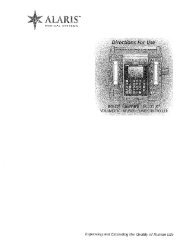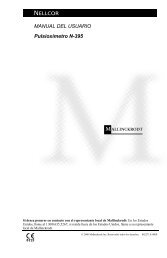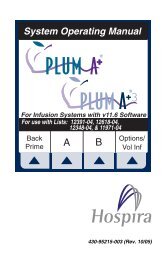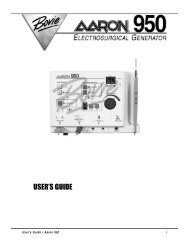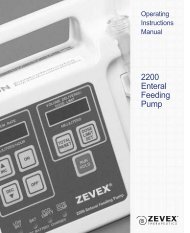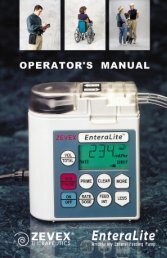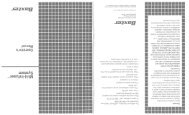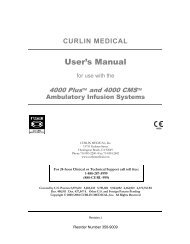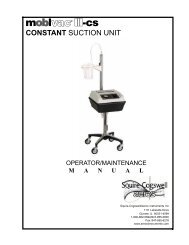Aaron Bovie Understanding Electrosurgery
Aaron Bovie Understanding Electrosurgery
Aaron Bovie Understanding Electrosurgery
Create successful ePaper yourself
Turn your PDF publications into a flip-book with our unique Google optimized e-Paper software.
© Copyright 2003, <strong>Bovie</strong> Medical Corporation (parent of <strong>Aaron</strong> Medical) St.Petersburg, FL. This publication may not be reprinted or distributed in part orin whole, by any means, whether electronic or hard copy, without the expresswritten permission of <strong>Bovie</strong> Medical Corporation.2<strong>Bovie</strong> ® /<strong>Aaron</strong> Medical ®
TABLE OF CONTENTSWhy should electrosurgery be important to you? ....................4Overview...................................................................................4Objectives .................................................................................4<strong>Electrosurgery</strong> Market ..............................................................4History ......................................................................................5Purpose of Electrosurgical Units (ESU’s)................................6Principles of Operation.............................................................6Monopolar <strong>Electrosurgery</strong>.................................................6Bipolar <strong>Electrosurgery</strong>.......................................................7Dispersive Electrodes ........................................................7Terms ........................................................................................8Current Density .................................................................8Isolated Power System ......................................................9Discrete vs. Non-Discrete .................................................9Cut .....................................................................................9Blended Cut.....................................................................10Coagulation......................................................................10Coagulation (Pinpoint) ....................................................11Fulguration (Spray) .........................................................11Electrosurgical Safety.............................................................12<strong>Bovie</strong> University 3
WHY SHOULD ELECTROSURGERYBE IMPORTANT TO YOU?<strong>Electrosurgery</strong> is used in 80% or more of all surgical procedures. In addition,with so many procedures being done in an outpatient environment today, this isan expanding opportunity.OVERVIEWThis booklet is intended to introduce the medical sales professional to the worldof electrosurgery. The information imparted here will also serve as a reminderto the more seasoned sales professional.This information should be used as a guide to growing the necessary knowledgeand confidence needed in the highly technical market of electrosurgery.OBJECTIVES• Describe the principles, history, and modalities of electrosurgery• Touch on the evolution of electrosurgery• Briefly discuss the market of electrosurgery• Discuss the risks involved in the use of electrosurgery• Give an understanding of the terms used in connection with electrosurgeryELECTROSURGERY MARKETWith the changes in the medical field over the last decade, a larger percentageof surgical procedures are moving out of the traditional operating room intoDr.’s offices and clinics.Although the opportunities are still huge in the hospital arena, this area can betime consuming and very specification restrictive. The areas of clinics andDr.’s offices provide opportunities to build relationships by providing top quality,state of the art equipment at affordable pricing.The areas of, Dermatology, Plastic Surgery, Gynecology, Ophthalmology,Urology, Otolaryngology, Dental, and lets not forget about the Family Practiceand the Veterinary arena, are just a few that require the use of electrosurgery.Virtually every Dr.’s office is a potential customer. The key here is to providethe Dr. with the correct unit for his needs. The qualifying question to yourpotential customers is, “Dr., do you use the Cut mode?” With that question outof the way it should be easy to provide the Dr. with the proper electrosurgicalunit for his needs.4<strong>Bovie</strong> ® /<strong>Aaron</strong> Medical ®
HISTORYMost surgeons the world over refer to theirelectrosurgical equipment or accessoriesas their “<strong>Bovie</strong>”. This is because electrosurgeryoriginated with Dr. William T.<strong>Bovie</strong>. Dr. <strong>Bovie</strong> received his PhD fromHarvard and worked there from 1914 –1927. <strong>Bovie</strong>, along with Neurosurgeon,Harvey W. Cushing, M.D., is credited withinventing the electrosurgical unit knowntoday as the “<strong>Bovie</strong>”.The first use of the electrosurgical generatorin an operating room was on October 1,1926, at Peter Bent, Brigham Hospital inBoston, Massachusetts. A few days earlier(September 28, 1926) Dr. Cushing had been Dr. William T. <strong>Bovie</strong>unsuccessful in removing a mass from a patient’s head due to its highlyvascular nature. In Dr. Cushing’s notes from October 1st he wrote, “…withDr. <strong>Bovie</strong>’s help I proceeded to take off most satisfactorily the remainingportion of tumor with practically none of the bleeding which was occasionedin the preceding operation.”Seventy-five years later, we continue to work on improving the work of Dr.<strong>Bovie</strong>. Amazingly enough except for the high advancements in the electronictechnology, the advancements of electrosurgery are relatively few. Again,except for electronic advancements, the advancements in electrosurgery canbe chronologically listed as follows:• 1980’s, the improvement from ground reference to isolated units• 1980’s, the improvement to discrete output units• 1980’s, the improvement of tissue impedance monitoring at the patient plate• 1987, the introduction of argon gas enhanced coagulation• 1990’s, the introduction of tissue response at the active electrodeThe work at <strong>Bovie</strong>/<strong>Aaron</strong> continues today to improve the performance ofelectrosurgery, but our sincere thanks go out to Dr. Cushing and William T.<strong>Bovie</strong> for their incredible invention.<strong>Bovie</strong> University 5
PURPOSE OF ELECTROSURGICAL UNITS (ESU’S)ESU’s are used for surgical cutting or to control bleeding by causingcoagulation (hemostasis) at the surgical site. They deliver high-frequencyelectrical currents and voltages through an active electrode, causing desiccation,vaporization, or charring of the target tissue.ESU’s are a useful tool in all aspects of the surgical arena: from the mostbasic wart removal, spider veins, or hair removal in a doctor’s office; to themost intricate open heart, orthopedic, and transplant procedures.An ESU, by definition, is a generator capable of producing a cutting and/orcoagulating clinical effect on tissue by the use of alternating current at a highfrequency (RF - radio frequency, also known as radio surgery). Voltages andcurrents may vary depending on the desired clinical effect.The <strong>Aaron</strong> 1250PRINCIPLES OF OPERATIONMonopolar <strong>Electrosurgery</strong>In monopolar electrosurgery, tissue is cut andcoagulated by completing an electrical circuitthat includes a high-frequency oscillator andamplifiers within the ESU, the patient plate,the connecting cables, and the electrodes.In most applications, electric current from theMonopolar HandpieceReceptacle on <strong>Aaron</strong> 12506<strong>Bovie</strong> ® /<strong>Aaron</strong> Medical ®
ESU is conducted through the surgical site with an active cable and electrode.The electrosurgical current is then dispersed through the patient to a return electrodereturning the energy to the generator to complete the path.Monopolar electrosurgery has the means of delivering energy to the tissuethrough several modalities (modes of operation): pure cut, blended cut,desiccation (or pinpoint), and spray (or fulguration)The delivery system of the monopolar electrosurgical generator can be ahand controlled pencil (reusable or disposable) or a foot controlled pencil.A number of accessories can be adapted to the foot control output jack todeliver energy through a number of instruments.Bipolar <strong>Electrosurgery</strong>In bipolar electrosurgery, two electrodes (generallythe tips of a pair forceps or scissors) serve as theequivalent of the active and dispersive leads in themonopolar mode. Bipolar electrosurgery does notrequire a patient plate. Electrosurgical current in thepatient is restricted to a small volume of tissue in theimmediate region of application of the forceps. Thisaffords greater control over the area to be coagulated.Bipolar Mode Selectoron <strong>Aaron</strong> 1250Damage to sensitive tissues in close proximity to the instrument can be avoided.There is less chance of current capacitively or directly arcing to surroundingstructures such as the bowel. Patient burns are virtually eliminated.Dispersive ElectrodesA dispersive electrode is an electrodewith a relatively large surface area whichis positioned on the patient in order toallow the high frequency current to flowback with a low current intensity in orderto prevent any physical effects, such asundesired burns.Solid PadSplit PadOver the years electrosurgery has advanced, so too have the types and styles ofdispersive electrodes. Early on in electrosurgery the only choice was a solidpad (at first a stainless steel plate) that was placed on the patient to disperse theheat of the RF energy. If the solid plate was not applied correctly or began tomove off the patient during the case, the ESU would continue to deliver energyto the tissue, causing a potentially dangerous situation. Advancements in technologydeveloped the ability to sense the tissue impedance at the patient plate(NEM - Neutral Electrode Monitoring). If the patient plate is not applied<strong>Bovie</strong> University 7
correctly or if the patient plate begins to come off during the case, the ESUwill discontinue to deliver energy and sound an audio alarm to alert themedical staff.TERMSCurrent Density<strong>Electrosurgery</strong> makes use of an intensely concentrated current to induce a heatenergy that is capable of a range of effects: from the drying out of cells – withconsequent coagulation of blood, to the vaporization of cells – permitting anelectrode to physically separate a path through living tissue. The degree ofcurrent concentration is called “current density.”Current density is one of the most important concepts in electrosurgery. Simplystated, current density is the amount of current concentration at a given point.In electrosurgery all of the RF current is forced to flow through the tiny areawhere the active electrode makes contact with the skin. At this point, thecurrent flow is concentrated intensely. The heat at the site is great enough toachieve cutting and coagulation.Current leaves the body via a dispersive electrode(grounding pad). The pad has a large surface areathus the current density is quite low. As long as thislarge, so-called “dispersive” electrode makes goodcontact with the skin it should offer a passage ofleast resistance for safe exit of the RF current fromthe patient. The large surface area generates littleheat, thanks to the low current density. A generatorsupplies RF to the active electrode. Current passesReturn ElectrodeCord ReceptacleES01 Standard Blade ElectrodeSplit Grounding Padwith Cordthrough the patient, exiting by way of the returnelectrode. It returns to the generator to completethe circuit. Without complete circular path, fromgenerator to patient, back to the generator, thecurrent should not flow.8<strong>Bovie</strong> ® /<strong>Aaron</strong> Medical ®
Isolated Power SystemAn isolated power system utilizes a transformer to isolate powerwith no voltage reference to ground. This is an important safetyfeature because it reduces the risk of alternate path burns. It issymbolized on the unit by an “F” in a box.Discrete vs. Non-DiscreteThere are two ways in which a unit can deliver its RF current: discrete or nondiscrete.Discrete output means that while several active instruments may beattached to the ESU only one accessory may be activated at a time. The RFcurrent will flow only through the one accessory on a “first come, first served”basis. This is a safety factor of major importance to the surgical staff. Someunits are equipped with non-discrete output. When an accessory is activatedany and all accessories connected to the unit are also activated. This means thatcare must be taken to isolate all additional accessories from the operative sight.Usually a safety cup, holster, or other similar device is used.Some manufacturers have developed what is known as “discrete output –simultaneous on demand” capabilities. These units are still truly discrete aspower is delivered on a “first come, first served basis,” however, power maybe shared in certain instances. Two surgeons may activate simultaneously in thesame mode (cutting or coagulation) and power is shared between the two activeelectrodes. Keeping in mind that electricity will follow the path of least resistance.The current will split unevenly between the two active electrodes, withthe majority of current flowing to the less impedance, more delicate tissue, andless current flowing to the more difficult, higher impedance tissue. Wheneverone surgeon ceases activation, the other surgeon once again receives full power.CutThe first clinical mode of a modernESU is cutting. The unit offers thesurgeon two types of cutting: purecut and blended cut. Pure cut is usedfor dissection only. Blended cutadds some hemostatic effect. Inpure cut the instrument performsmuch like a stainless steel scalpel,in that the surgeon has little or nocontrol over bleeding. There are,however, some notable differences.Cut Mode Controls on <strong>Aaron</strong> 1250<strong>Bovie</strong> University 9
One, the cutting effect of an electrosurgical instrument results from the heat ofa current passing through tissue. Thus, it is the current that parts the tissue andnot the instrument. The parting of tissue actually precedes the leading edge ofthe active electrode by a microscopic distance. Cutting is virtually effortless, sothe surgeon may direct most of his attention to guiding the instrument. He neednot apply as much pressure as he must with a scalpel.Two, however sharp it may appear, a stainless steel scalpel requires pressureand some effort in making the incision. In contrast, the electrosurgical instrumentmakes sharply defined incisions with relative ease. By adjusting thepower to the desired level, the active electrode encounters little resistanceto its passage through tissue.Blend Mode Selectoron <strong>Aaron</strong> 1250Blended CutIn addition to the pure cut, most ESU’s today offer ablended cut. The term “blended” does not refer to ablend of currents, but rather a blend of surgical effects.The blended cut permits the surgeon to cut and coagulateat the same time. In a pure cut the heat energy isso great that cells vaporize. But in a blended cut, coolingperiods slow down the action to a dehydrating crawl. Cell wall explosionand vaporization are replaced by the slow dehydration of cellular fluid and protein.This stops the bleeding at the moment the cuts are actually being made. Byadjusting the blend the surgeon can get varying degrees of hemostasis. A blendedcut is ideal for sealing off small bleeders when cutting through soft tissue.It is also used to resect masses of tissue and to reduce and recontour redundanttissue where the cutting is continuous, but the surgeon wishes to minimizebleeding and work in a clear field.CoagulationThe second clinical mode ofelectrosurgical units is coagulation.There are two types of coagulation:Coagulation (also known as pinpoint)and Fulguration (also referredto as spray). They differ primarilyin how they are applied. To applypinpoint coagulation, the surgeonholds the electrode in physical contactwith or against the tissue.When fulgurating, the surgeon holdsthe electrode some distance awayCoag Mode Controls on <strong>Aaron</strong> 125010<strong>Bovie</strong> ® /<strong>Aaron</strong> Medical ®
from the tissue and the RF current is delivered to tissue by way of sparks jumpingcross the airspace contacting the tissue.Coagulation (Pinpoint)Factors affecting pinpoint coagulation include;current density, period of contact, and surgicaltechnique. Therefore, when using pinpointcoagulation the time that the electrode remainsin contact with the tissue is important. The tipshould make only light, momentary contactwith the surface. Power should be adequate to deliver a desired clinical effect.The desired effect for pinpoint coagulation is to stop local bleeding. Here, aninterrupted current supplies controlled dehydration. The drying out effects of apure coagulating current produce a zone of coagulation necrosis that is limitedto the surface layers of the tissue.Fulguration (Spray)Fulguration is another type of coagulation.Fulguration can be defined as non-contactcoagulation in which current sparks or jumpsfrom the active electrode to the tissue.Coagulation Mode Selectoron <strong>Aaron</strong> 1250Fulguration Mode Selectoron <strong>Aaron</strong> 1250Not only is fulguration an important electrosurgicalmodality for sealing off small hiddenbleeders which surgeons have difficulty locating, fulguration is especially usefulfor those areas with large bleeders. Many surgeons use spray coagulation todestroy the surface layers of cells in the bed from which a suspicious lesion hasbeen removed, to prevent possible migration of malignant cells.Good technique helps avoid charring. The secret is to keep the electrodemoving at all times. This prevents the build up of heat in one area. Usually,the surgeon moves the electrode over the areas to be treated just long enoughto dehydrate the surface which forms an even and pliable eschar. The idealeffect is coagulation without a blackened eschar.<strong>Bovie</strong> University 11
ELECTROSURGICAL SAFETYElectrosurgical safety measures are intended to minimize the potential forelectrical and other hazards before, during and after procedures that involvethe therapeutic application of RF energy. The two most common hazardsassociated with the use of any electrosurgical device are explosion/fire andburns. <strong>Electrosurgery</strong> can also interfere with other electromedical devicesor produce a noxious smoke with, as yet, undefined harmful effects.Explosion and fire can occur if electrical sparks ignite flammable gases orsolutions. Although, fire hazards have been greatly reduced over the years,lack of appropriate safety measures are still causes for concern.Most flammable anesthetic gases have been eliminated from the operatingroom; alcohol preps and other flammable vapors can ignite if present whenan active electrode is used in the same area. Inadvertent activation of an activeelectrode positioned on sponges, drapes, or in an oxygen-enriched atmospherecan result in fires.Unintended burns are the least understood and most dangerous hazards insurgery. A patient may be burned in three ways:• intended burns at the active electrode site• unintended burns at the active electrode site (direct coupling)• unintended burns at an alternate site (capacitive coupling)Alternate path burns are all but eliminated with the design of the isolatedunits of today. Ground reference units, which are still in the surgery arena,were prone to this type of burn if the patient were touching a grounded areaor if the pad were not placed on the patient. In cases like this the energywould find ground through the easiest means possible. With isolated units,if the energy does not find its way to the dispersive electrode the unit willstop delivering energy.Capacitive coupling is defined as the establishment of currents between twoconductors that are separated by an insulator. In electrosurgery, the phenomenonof capacitive coupling between an insulated electrode and a surrounding metaltrocar with plastic screw threads is a possible example of an inadvertent injury.Direct coupling is defined as intended or unintended contact between activeelectrode and tissue. Unintended direct coupling may occur due to faultyinsulation on an active electrode which can be the result of continual reprocessingor deterioration caused by normal wear and tear of instruments. Directcoupling caused by insulation breakdown is potentially more devastating thancapacitive coupling12<strong>Bovie</strong> ® /<strong>Aaron</strong> Medical ®
The Association of Operation Room Nurses (AORN) recommends the use ofa smoke evacuation system to protect operating room staff from inhaling thesmoke generated during electrosurgery procedures. AORN cites the potentialfor bacterial and viral contamination of the smoke and warns that gaseousby-products can be toxic and mutagenic.Although the above-mentioned safety hazards exist, and are all inherent to theuse of electrosurgery, they are all controllable hazards. Through ongoing educationto personnel these hazards can be eliminated. Education should includethe principles of electrosurgery and proper operation, care, and handling of thespecific electrosurgical equipment used in the practice setting. The most effectivesafety system in electrosurgery is a knowledgeable doctor, nurse, and salesforce. A basic understanding of electrosurgery and adherence to the necessaryprecautions will assure a safe environment for both patient and staff.<strong>Bovie</strong> University 13
Notes14<strong>Bovie</strong> ® /<strong>Aaron</strong> Medical ®
Notes<strong>Bovie</strong> University 15
7100 30th Ave. NorthSt. Petersburg, FL 33710U.S. Phone 1-800-537-2790U.S. Fax 1-800-323-1640International Phone +727-384-2323International Fax +727-347-9144www.aaronmed.com • sales@aaronmed.com10M 7/03 MC-55-049-001 Rev. 1



